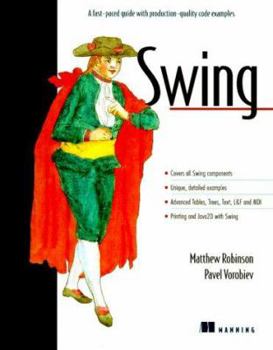Swing
Select Format
Select Condition 
Book Overview
This book builds on the successful approach of the first edition of Swing, once again taking the power and flexibility of Java's Swing library to its limits. Using a fast-paced style, it starts by... This description may be from another edition of this product.
Format:Paperback
Language:English
ISBN:1884777848
ISBN13:9781884777844
Release Date:December 1999
Publisher:Manning Publications
Length:917 Pages
Weight:3.37 lbs.
Dimensions:2.1" x 7.4" x 9.3"
Customer Reviews
5 ratings
The Bible of Swing
Published by Thriftbooks.com User , 21 years ago
Two years ago, the JavaRanch reviewer, Anmarie Ziegler, wrote this about the first edition: "Overall this is an excellent book, and I would recommend it for the intermediate to advanced Swing developer." The same can be said of the second edition of "Swing". This edition has been updated to bring it up to Java 1.4 with new examples, new components, and three new chapters. You should note that this book is not for beginners. If "threads", "anonymous classes", or "event handling" are foreign words to you then you should go over the basic Swing chapters in a Java intro book such as "Beginning Java 2" by Ivor Horton. If you consider yourself at least an intermediate Java programmer and are comfortable with the basics of the AWT and you want to learn Swing very well then you are ready for this book. The authors have written the Bible of Swing. This book covers not just the basics of Swing but goes beyond that to teach you how to build your own Swing components. The cover states that the book contains, "production quality code" and this is exactly what it contains. You will find no simple "Hello World" examples but instead demonstrations of how to make use of the real power of Swing. The coding samples you will find in this book are extremely detailed and well commented. If you want to learn how to be a competent Swing developer then you should get this book.
Strongly impressed
Published by Thriftbooks.com User , 23 years ago
I read this book while buying O'Reilly's "Java Swing," mainly because I noticed that one of the authors of this book gave a glowing review of the O'Reilly book. Wonderful thing to occur, since I found this book very useful and unique.True to the cover, it has "production quality" examples written in Swing, including an entire word processor in the section about JEditorPane. I am downloading the code at this moment to test it out. The presentation in this book for each chapter is roughly: Show a class' place in the Swing hierarchy, explain the concepts and useful methods, then iteratively develop an interesting application. These applications start out with simple features, then the next revision has another new feature.. and so forth. Bugs encountered ARE REPORTED. That, along with the O'Reilly review I mentioned earlier, points to a good honesty. I have no problem commending them by paying for their book.For beginners to Swing, I would recommend Sun's tutorial book on Swing (by Mary Campione). You can check it out for free and then perhaps buy it. You could also learn Swing from this book, but perhaps you would have more of a cut & paste understanding. Depends.For those used to Swing, this book really files in the big gaping hole in Java's documentation: Good examples of little things being used. Cuts down on experimentation. I know from personal experience that Sun's jdk HTML renderer blows, but this book tells you that it does, and where to go to find out when it stops blowing so badly.
Very well written with good examples
Published by Thriftbooks.com User , 24 years ago
One of the best book for understanding Swing components. I have had problems with rendering particularly with JList, JTree, and after eeading this book, everything seems so simple. The material is so unique that will be very helpful for serious Java/Swing programmers.
A must-have for serious Swing developer
Published by Thriftbooks.com User , 24 years ago
I found this book the best for intermediate to seasoned Swing developer. Excellent coverage on some Swing topics not covered in sufficient depth elsewhere - such as tables, trees and GridBagLayout. The book is considered a classic in Java Swing developers community and is highly recommended to anyone with some basic Swing understanding who wants to know it real well and use it. The code examples are quite practical, I used the concepts from the book several times in my projects.
Invaluable source of techniques
Published by Thriftbooks.com User , 24 years ago
Excellent treatment of this flexible GUI API presenting both basic and advanced usage of JFC Swing with great care. I especially like the way all examples are annotated and fully explained. I hope this book's source code style will be emulated in other publications! The book can also be regarded as an easy-to-follow reference for JFC Swing techniques. Every example is a complete application; this allows any snippet of code you pull out to be derived in context. I find this format ideal and it provides the convenient ability to skip around in any chapter to exactly what might be needed for a given task.From my initial comments, you can tell I truly like and recommend this book. The only negatives I see right now are those last four chapters not being printed but only available on-line (I dislike this trend). Also, the book stressed Java 2 but it would have been nice to see them mention that 95% of the book applies to the JDK1.1.x with the JFC Swing extension (e.g. simply reference the single file swingall.jar); those examples will run with Java 1.1 unchanged.




